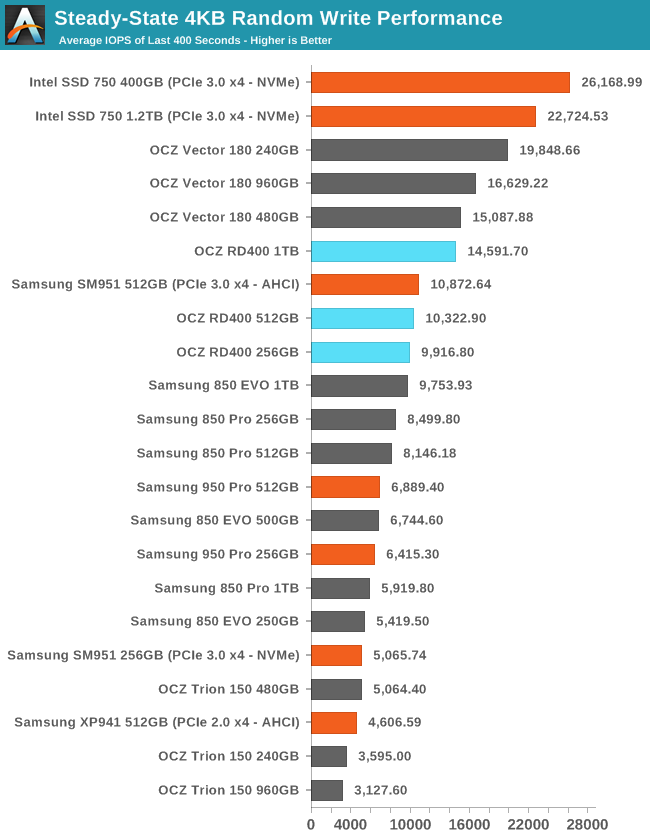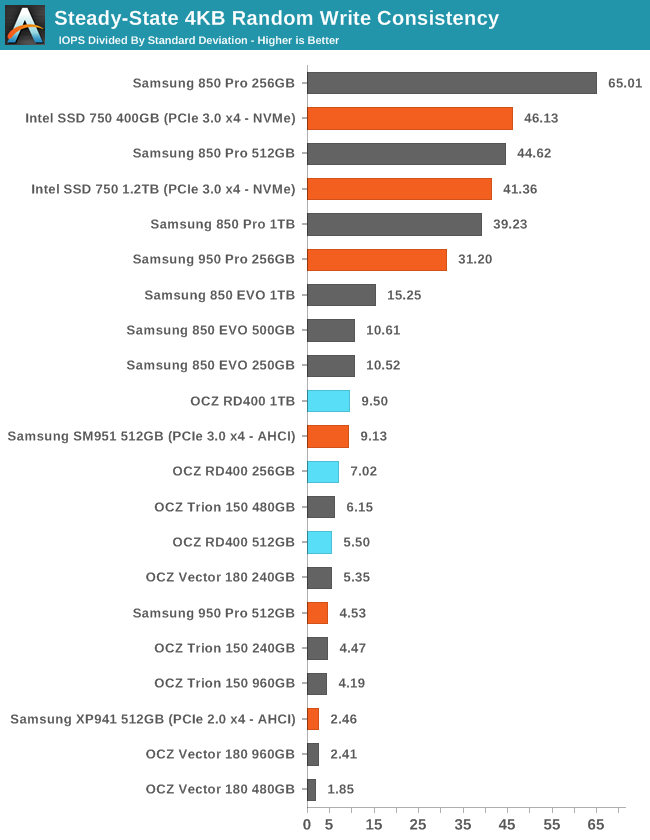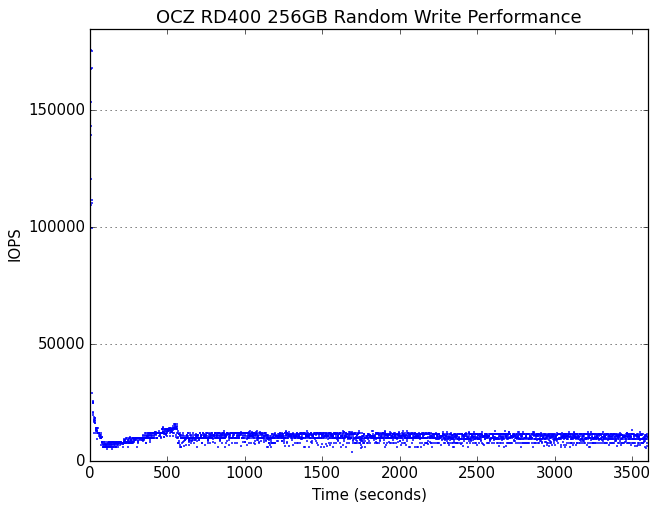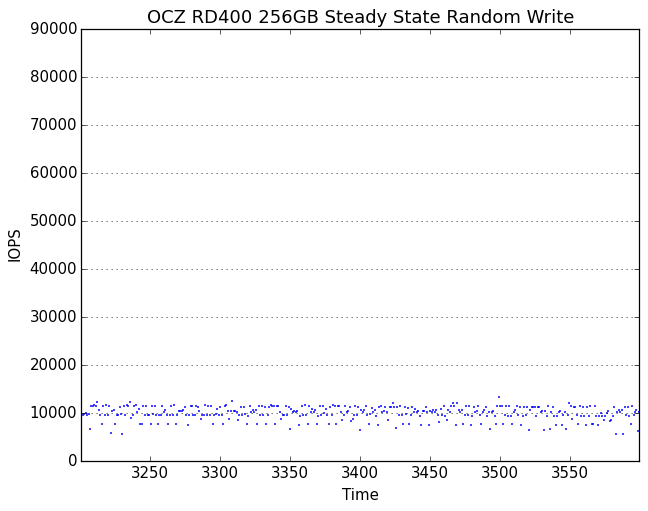The Toshiba OCZ RD400 (256GB, 512GB, 1TB) M.2 PCIe SSD Review
by Billy Tallis on May 25, 2016 8:02 AM ESTPerformance Consistency
Our performance consistency test explores the extent to which a drive can reliably sustain performance during a long-duration random write test. Specifications for consumer drives typically list peak performance numbers only attainable in ideal conditions. The performance in a worst-case scenario can be drastically different as over the course of a long test drives can run out of spare area, have to start performing garbage collection, and sometimes even reach power or thermal limits.
In addition to an overall decline in performance, a long test can show patterns in how performance varies on shorter timescales. Some drives will exhibit very little variance in performance from second to second, while others will show massive drops in performance during each garbage collection cycle but otherwise maintain good performance, and others show constantly wide variance. If a drive periodically slows to hard drive levels of performance, it may feel slow to use even if its overall average performance is very high.
To maximally stress the drive's controller and force it to perform garbage collection and wear leveling, this test conducts 4kB random writes with a queue depth of 32. The drive is filled before the start of the test, and the test duration is one hour. Any spare area will be exhausted early in the test and by the end of the hour even the largest drives with the most overprovisioning will have reached a steady state. We use the last 400 seconds of the test to score the drive both on steady-state average writes per second and on its performance divided by the standard deviation.

The RD400 sustains good random write performance, but the controllers and firmware in the OCZ Vector 180 and Intel 750 were designed with this kind of test in mind, and it shows. PCIe and NVMe don't help appreciably when the performance bottleneck is all the bookkeeping inside the controller, but NVMe controllers tend to have at least adequate processing power.

Most Samsung and Intel drives are much more consistent than the RD400, but the latter's score is fine for a client drive.
 |
|||||||||
| Default | |||||||||
| 25% Over-Provisioning | |||||||||
The 512GB RD400 shows oddly different behavior from the other two capacities when tested with overprovisioning, but the RD400 results are all good looking with no extremely low performance outliers.
 |
|||||||||
| Default | |||||||||
| 25% Over-Provisioning | |||||||||
The minimum random write performance of the RD400 is as good as the average performance of most SATA drives. There is some periodic variation apparent for the 512GB and 1TB models in the form of steep drops that last only a few seconds.










40 Comments
View All Comments
Meteor2 - Thursday, May 26, 2016 - link
So are we saying NVMe is only really useful for enterprise applications? There just aren't consumer use cases where drive speed is now the limiting performance factor?stux - Thursday, May 26, 2016 - link
This might be the case in Windows, but I've found with OSX, one of the biggest upgrades has been sata3 to PCIe ssd gen 1 to 2 and then 3Ien 0.5 to 1 to 2GB/s
This was evident with all the recent MacBook Pro 15" upgrades and also with PCIe ssds in some Mac Pro towers.
SunnyNW - Wednesday, May 25, 2016 - link
Is the flash controller made on the same memory process or is it made on a separate logic process? I think its made on a separate (logic) process and if so would that be 28nm for most controllers? And is the manufacturing out sourced to TSMC or in-house for most?Ryan Smith - Wednesday, May 25, 2016 - link
Controllers are made on a separate logic process.Kristian Vättö - Thursday, May 26, 2016 - link
The PCIe NVMe controllers are mostly 28nm from what I've heard. SATA controllers can be anything from 40nm to +55nm. Like nearly all logic manufacturing, it's outsourced to TSMC and the like.BangkokTech - Friday, May 27, 2016 - link
Recently got the SM950 pro 512. Large writes slow down after 30 seconds. It starts out ETA 3 minutes, 10 minutes later it's only 70% complete. I read into it; evidently these M.2 cards heat up and slow down. There is absolutely no heatsink on the card. Running them on a PCI expansion card would allow headspace for small heatsinks.BangkokTech - Friday, May 27, 2016 - link
Are any of you aware of a ribbon cable/riser cable I could use to get this M.2 card off my motherboard and move it to a cooler part of my case? I'm out of PCI slots for these expansion cards.Billy Tallis - Saturday, May 28, 2016 - link
Even with the degree of thermal throttling I've observed when not using any kind of heatsink, the 512GB Samsung 950 Pro should only take ~12-13 minutes to fill to capacity with sequential writes. I suspect that your bottleneck is whatever is the source of the data being written, not the 950 Pro.BiTesterEmailer - Wednesday, July 20, 2016 - link
Informative and detailed as always.